An Adventure Story
Enlarge
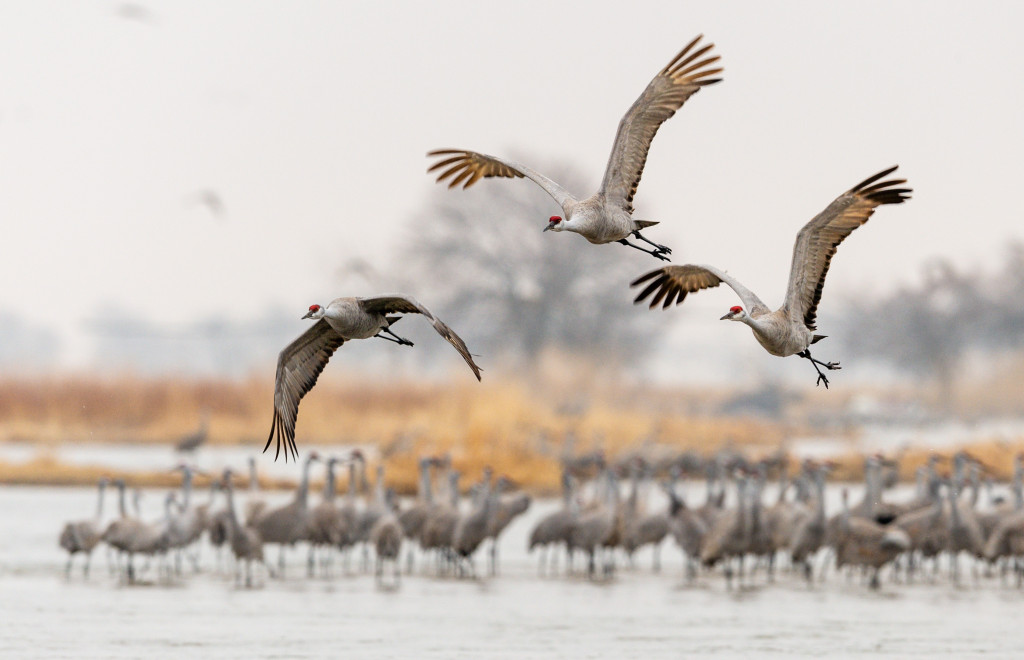
Story and Photos by Eric Fowler
I’m often asked about the best place to see the sandhill cranes during their annual spring stopover in Nebraska. My reply: Do you want to see the cranes or experience them?
The former requires getting a reservation in a riverside viewing blind, several of which are available in the central Platte River Valley. But if you really want to experience the cranes, I tell them, you need to spend the night with the birds on the river.
I’ve spent time pursuing cranes each spring with my camera since joining the Nebraskaland Magazine staff in 2001. But I hadn’t slept with them until 2015. The year before, my friend Chad Gideon invited me to come see the cranes on land his family owns on the south side of the river between Wood River and Alda. That reach can hold more than 40,000 cranes during the peak of the migration. I chose the wrong spot in the little time I spent there, wishing that I had gotten closer to the birds — you always want to get closer.
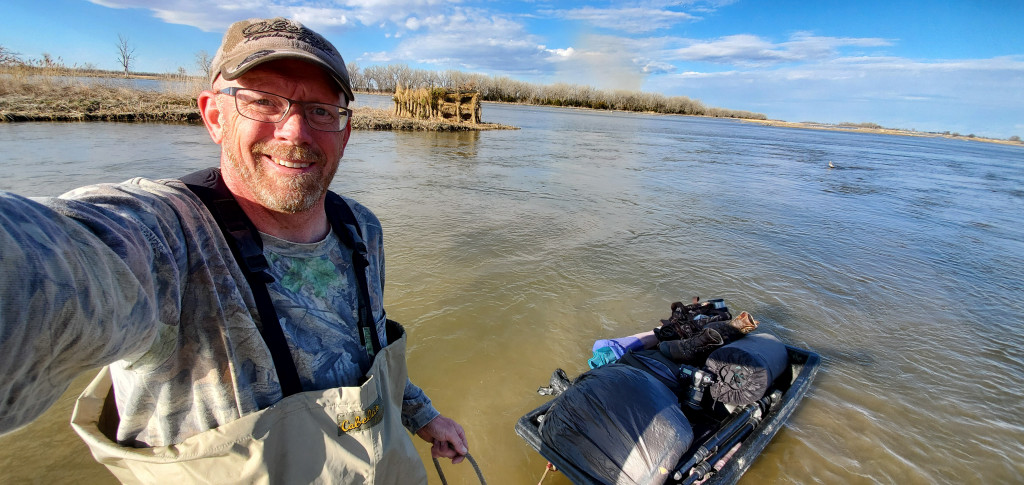
So in 2015, I pitched a tent in the middle of an island and set up a homemade layout blind on the west end. I spent two nights out there, crawling 30 yards between the blind and tent in the morning and evening. The cranes were close, but I wanted to get closer.
Chad grew up hunting with his father, Bill, and brother, Matt, but developed a love for wildlife that extended beyond hunting. He knew the crane roost on his family’s land was something special and wanted to share it with others. So in 2016, he started offering open-air crane tours, guiding customers to a row of lawn chairs set up behind a screen of brush on the riverbank. There, his joy is watching people’s faces light up and glow as the cranes return to the river in the evening, flying directly overhead from every direction, sometimes seeming like the flight will never end.
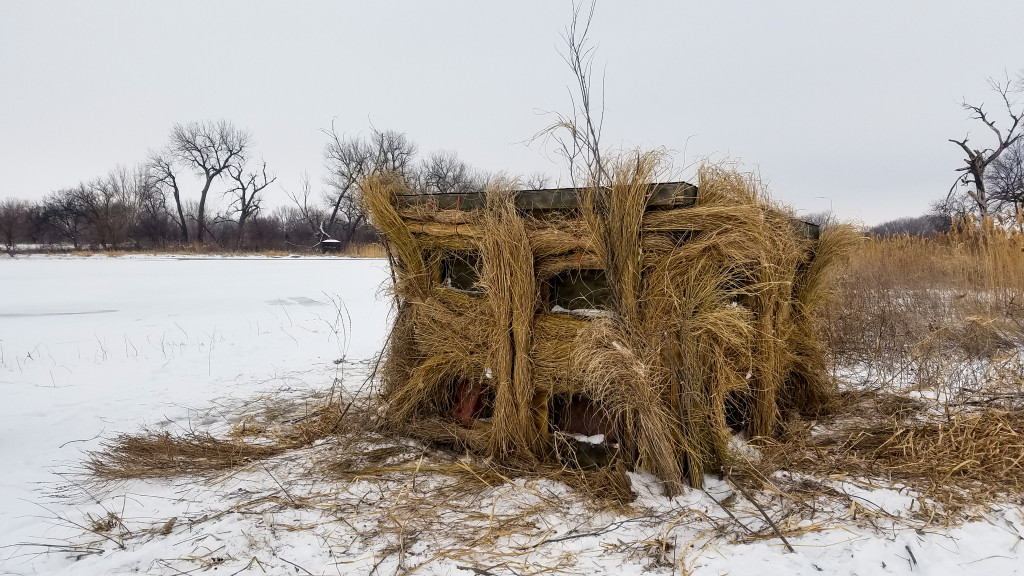
In 2017, the Gideons expanded the operation, offering the family’s cabin for rent and adopting the name Crane Cabin Retreat. Chad added a viewing blind on the riverbank that he rents out to customers who, if they wish, can spend the night. A few do. Later that year, he asked me what I thought about putting another blind on the island.
When I’d camped there, I would’ve preferred to set up on the east end of the island, knowing it would be closer to the cranes. But there wasn’t enough cover to conceal movement between the tent and blind. And I’m too old to spend a night in that cozy little blind. “When can we start?” I said.
We wanted the blind to be big enough to sleep two, with a little room to spare, so it’s just shy of 8-feet square. I wanted lots of windows, both high and low. It has 12, four on each side facing water: the main channel to the north, the smaller side channel to the south and the wide open river to the east, facing directly into the rising sun. The lower windows are located a foot or 2 above the waterline. That crane’s-eye view allows you to capture photos with a perspective not offered by other photo and viewing blinds on the river, which are typically built on the bank 4 feet, give or take, above the waterline. A friend of Chad’s took our notes and drew up plans, and his cousin framed the blind, which we bolted together on the island just in time for the cranes to arrive in 2018.
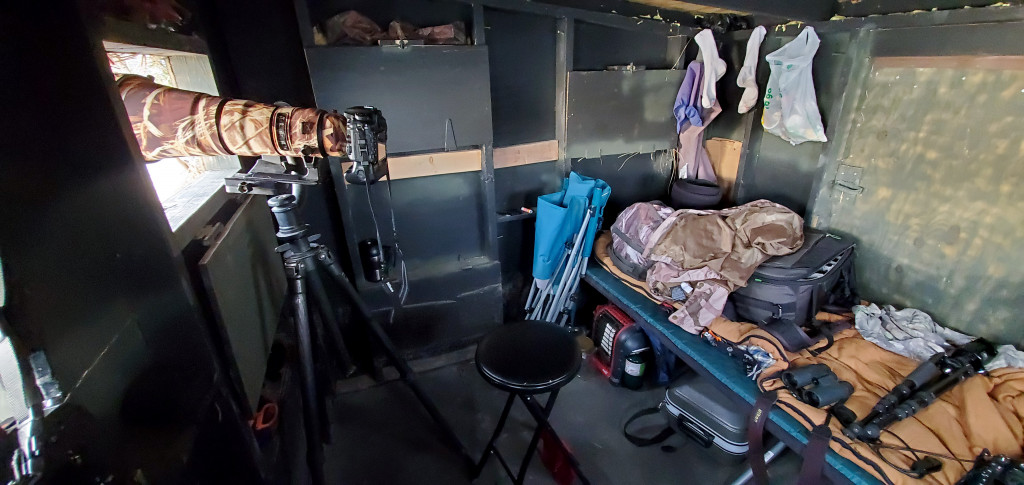
Anyone can see the cranes during the migration, and plenty do, coming from around the globe to witness this world-class spectacle. Drive down almost any county road within a few miles of the Platte and you can see thousands of cranes feeding in the fields. Stand on the bridge over the Platte on the hike-bike trail at Fort Kearny SRA or one of the viewing decks along the river in the morning or evening, and you can watch thousands fly overhead.
Visit a riverside blind, however, and you can literally have thousands of cranes outside your window. Whether you’re watching them return to their roost in the evening or leave to feed in the morning, they come in waves, producing a cacophony of sound that can seem deafening, rivaled in this state only by the crowd in Memorial Stadium on a fall Saturday. Not only do you see and hear the cranes, you feel them. That sound is what I’m referring to when I tell people they need to experience the cranes.
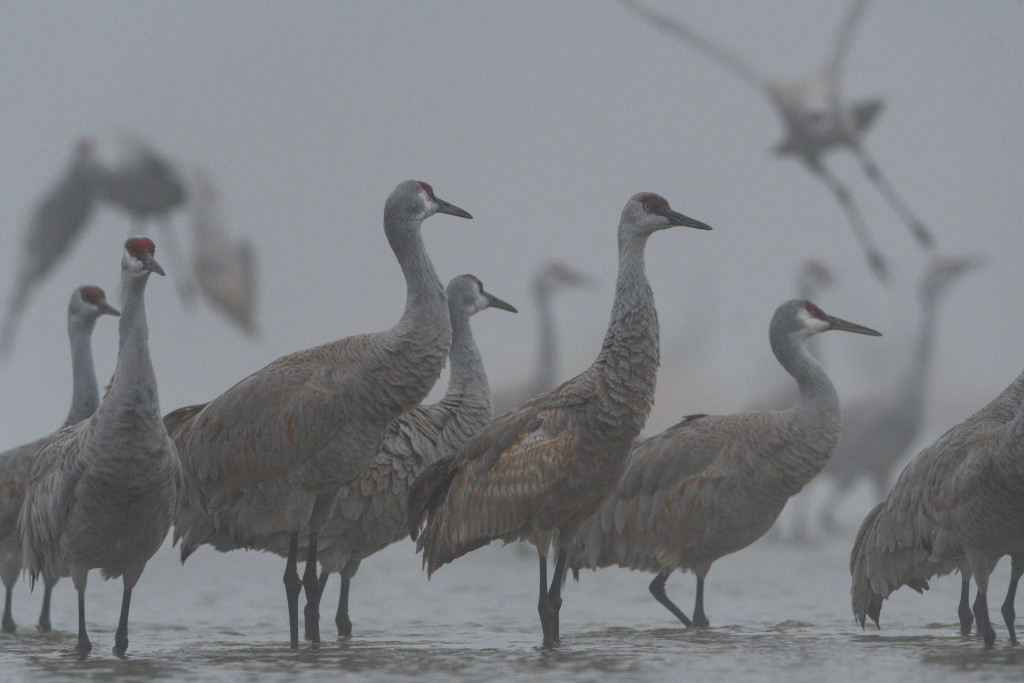
When I christened the island blind in March 2018, it was everything I’d hoped it would be. The cranes didn’t fill the river in front of me until after sunset. But with birds 30 yards from the window, I kept photographing them well into darkness, silhouetted by the lights from the Grand Island Interchange.
The cranes will let you sleep at night. The darker it gets, the quieter they get. There’s always the chance they will wake you, though, when something, I’m never sure what, disturbs them in the middle of the night, and their deafening roar returns as the birds rise from the river and look for another place to sit back down.
I was awake, sipping coffee I had packed in a thermos and eating a muffin, the following morning when the light murmur of cranes outside my window turned to a roar. The birds wouldn’t be as close as I’d liked at sunrise. That’s life for a photographer. And there were still photos to be had.
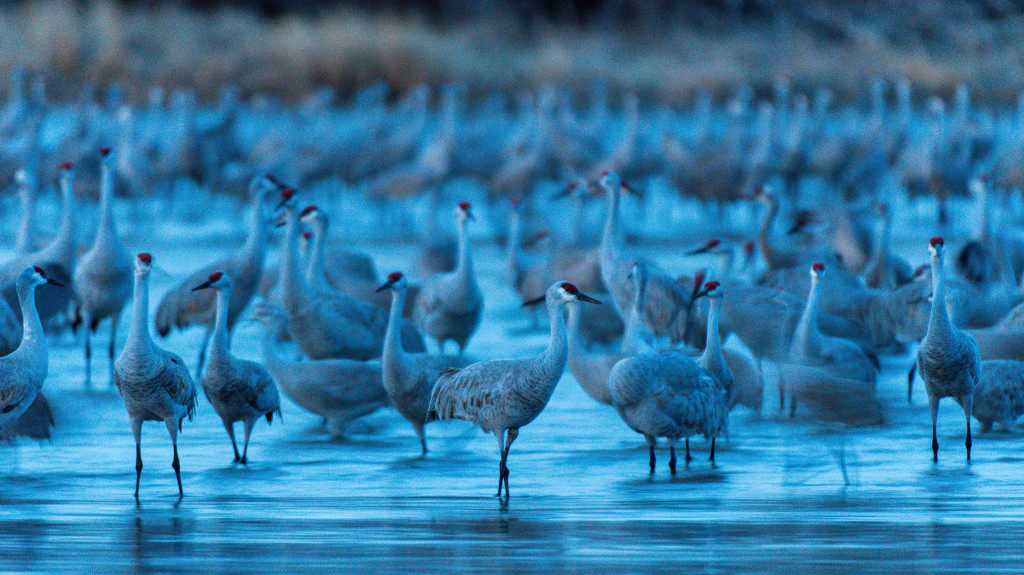
It’s not just cranes you can see and photograph from Chad’s blind. I’ve had a beaver crawl up on the sand in front of the blind. Snow geese were mixed in with the cranes on one trip. A northern harrier stopped to chew on a snow goose carcass stuck on a sandbar on another. Ducks and Canada geese are almost always around, and there’s a good chance white-tailed deer will cross the river nearby. And last, but not least, a pair of bald eagles decided to build a nest in a cottonwood about 200 yards downriver after the island blind was built.
Staying in this blind is a commitment and not for the meek. The river isn’t deep, but you will need chest waders to reach it, and the strength to pull through the occasional patch of “quick sand” you will encounter on the 150-yard crossing. Chad provides a small boat you can use to haul your gear to the blind and a cot to sleep on, but you’ll need to bring your own cold-weather camping gear, dinner and breakfast, and whatever adult beverage you’d like to sip on while you listen to the cranes settle in for the night. And you can’t be bothered by going to the restroom in something called a Luggable Loo (Google it.). And once you’re in the blind, you will stay there until the cranes leave the following morning. Fail to do so and you will scare the birds, spoil your trip and quite possibly that of those with reservations in the days to come. And you won’t be welcomed back.
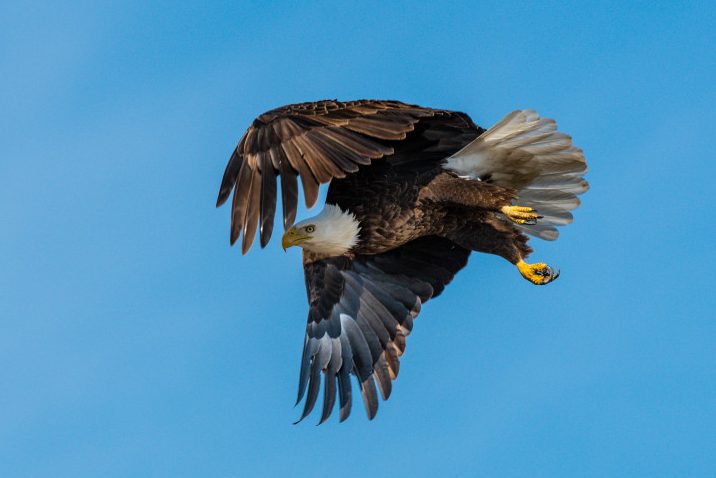
I’ve spent five nights in the blind. I would have added another night or two had I not taken the spring of 2019 off for shoulder surgery. Being on the river would have been much more fun.
Each day in the blind has been different. More often than not, the cranes will be close: other photographers with better luck have had them as close as 10 yards. And you might have birds on three sides of the blind.
Most photo opportunities come in the morning. In this reach, the cranes start piling back into the river downstream near the Alda bridge when they return from staging areas in nearby fields. By the time they fill the river from east to west and reach the island, it can be well after sunset. During the peak of the migration in mid- to late March, the string of cranes will extend well to the west of the blind. When the sun rises, you can watch them stretch, preen and dance before they fly off to feed.
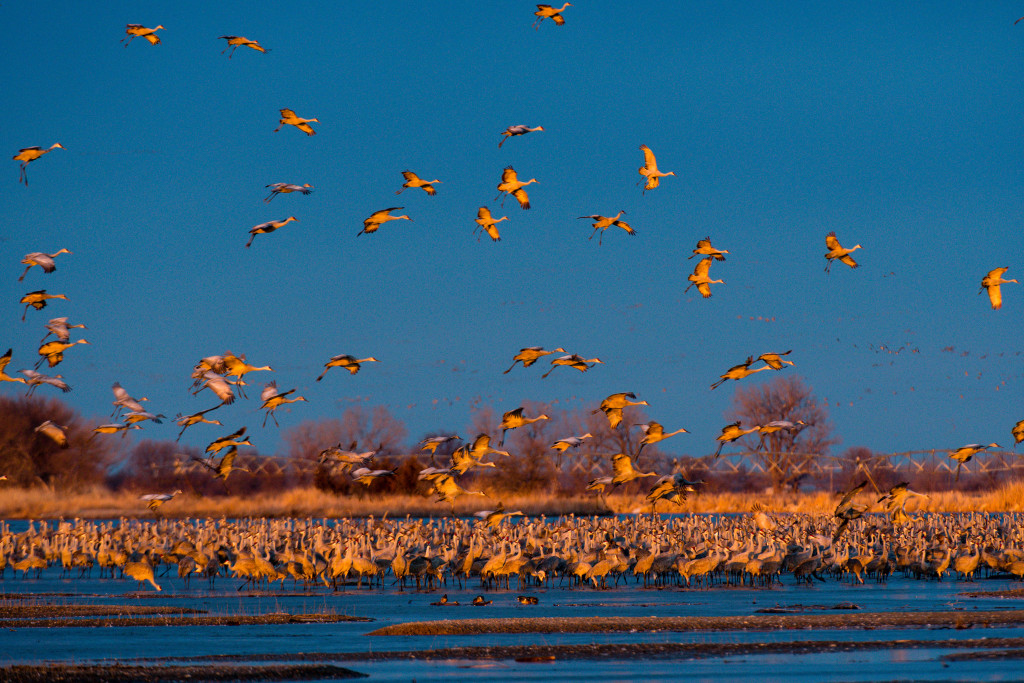
Weather makes each day different, too. I’ve been greeted by cloudless, bluebird days, colorful sunrises and, last spring, two straight mornings of dense fog. I hope to be able to make time to be there during a snowstorm at some point. No matter where you are on the river, changing light and your proximity to cranes is what keeps photographers coming back each year. Each day provides a different photo opportunity. You simply take what you’re given and make the most of it. I’ve captured some great images, but I’m still waiting to capture the perfect one. I can see it in my mind.
Which is why I’ll be spending a night or two with the cranes again this spring. I hope they’ll be closer. ■
Crane Viewing Opportunities
Overnight blinds are a great way for photographers to experience the sandhill crane migration on the Platte River in Nebraska. And this spring, thanks to the COVID-19 pandemic, they may be one of the best ways to do so while staying socially distant.
With the pandemic still at play, The Crane Trust and The Iain Nicolson Audubon Center at Rowe Sanctuary will once again keep their visitor centers closed this spring. The Crane Trust has cancelled all offerings, including its group viewing blind tours and photography workshops. While subject to change, Rowe Sanctuary is still planning on offering group viewing blinds tours, but has reduced blind capacity by one-third. It will also offer its overnight photography blinds. That is slightly better than last year, when both cancelled most offerings just as the cranes were arriving. It will be another big loss for these organizations, which rely on income from the crane season to support their mission the rest of the year.
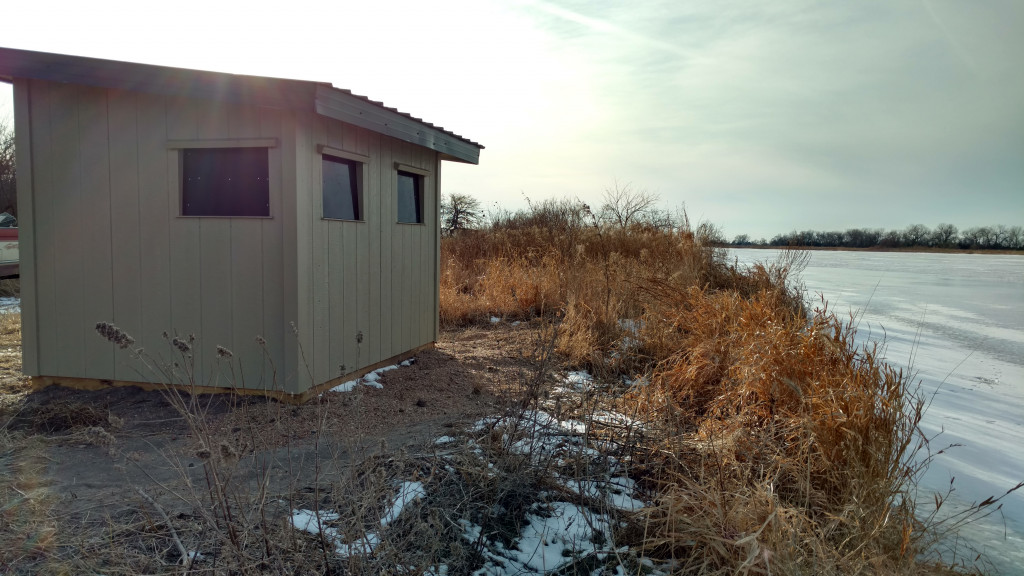
Rowe upgraded its four overnight photography blinds in recent years, making them more weather tight and taller than the blinds they had operated for years. Each holds two people.
Crane Cabin Retreat has two blinds. One on an island requires an overnight stay. Another on the bank allows visitors the choice of spending the night or leaving after dark. Guided, open air crane tours are another option for socially distanced viewing.
The photo blinds are popular and may be in higher demand than normal, so call for reservations if you are interested. They require visitors arrive in the afternoon and do not leave until after the cranes have left the river the following morning. Cold weather camping gear and warm clothing is essential and not provided. Primitive “restrooms” are provided.
If you can’t make it to the river this spring, The Crane Trust is offering Virtual Crane Tours and Rowe will continue to offer its popular Crane Cam.
• Crane Cabin Retreat, Wood River
Two overnight photo blinds, open-air crane tours.
facebook.com/crane-cabin-retreat
308-383-6913
• The Crane Trust, Alda
Group viewing blinds and all-inclusive photo tours and workshops, all cancelled for 2021, will return in 2022.
308-382-1820
cranetrust.org
• Iain Nicolson Audubon Center at Rowe Sanctuary, Gibbon
Four overnight photo blinds, group viewing blinds.
308-468-5282
rowe.audubon.org
The post Sleeping with the Cranes appeared first on Nebraskaland Magazine.
















